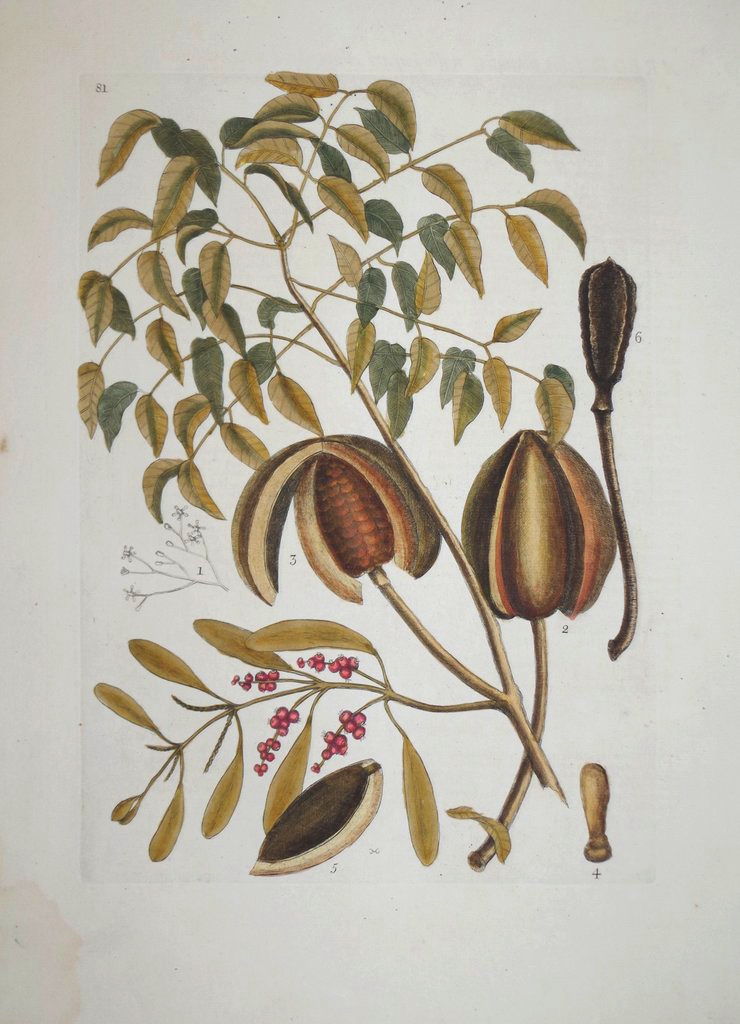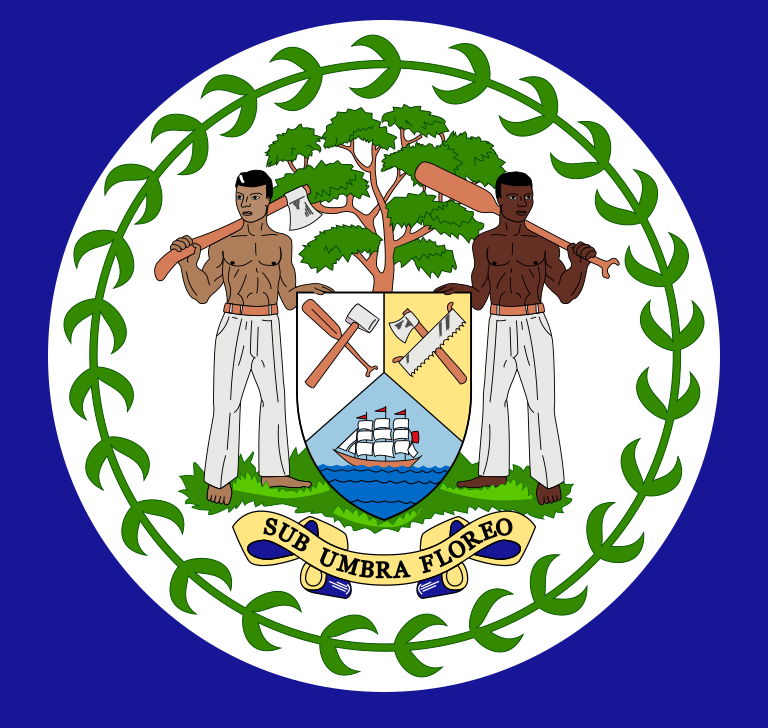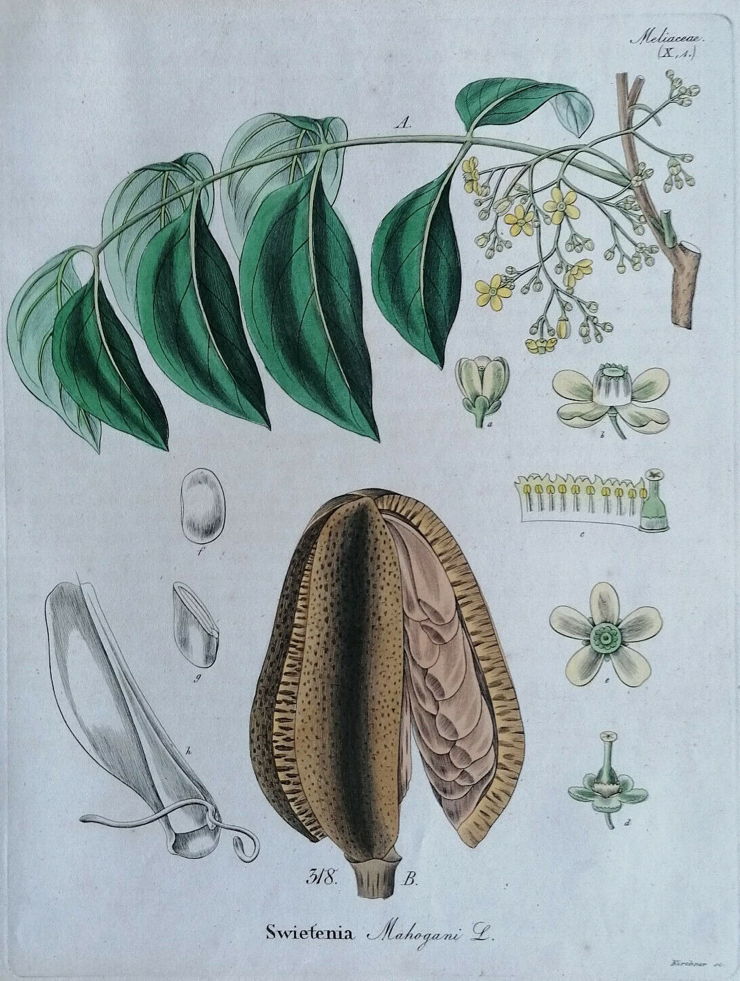Shipping country
Wood Species
Mahogany: the national tree of Belize
The national tree of Belize is mahogany, a highly valued and sought after wood throughout the world!

Source: Marc Catesby, The Natural History of Carolina, Florida and the Bahama Islands
The botanical drawing shows, among other things, the leaf and fruit of the large-leaved mahogany tree (Swietenia macrophylla), which provides the genuine mahogany that is highly sought after throughout the world. It is the national tree of Belize, formerly British Honduras. One of its trade names is Honduras mahogany. In the past, wood lots were often named after the port from which they were shipped or the country from which they came.
Other trade names include Brazilian and Venezuelan mahogany. These are usually the same botanical species, but may differ from each other due to different growing conditions. To illustrate, the wood of a pedunculate oak from Slovenia is usually uniform in growth, fairly soft, easy to work, and of an even color. In contrast, a English oak grown in northern Germany often yields tougher, harder and coarser wood because it has grown more slowly. In the trade, they are sometimes referred to as Slavonian oak and native oak.
The natural range is part of tropical South America and Central America. A mature tree can reach an average height of 45 meters and a diameter of 2.5 meters. The trunk usually has heavy plank roots. At maturity, the bark is dark and deeply furrowed. Characteristic are the large, evenly pinnate leaves that can reach 45 centimeters in length, the stem leaves are in 3 to 6 pairs up to 15 centimeters long. The flowers are small, white and paniculate. The adult fruit is a large woody capsule that grows straight up and is therefore called sky fruit. The fruit contains winged seeds that are dispersed by the wind after the fruit bursts open and can fly up to 500 meters from the mother tree.
The mahogany tree is the national tree of Belize, it is shown on the flag. Below it is the Latin saying: "sub umbra floreo". ("I bloom in the shade"). Belize is the only Central American country that does not have direct access to the Pacific Ocean, Belize lies in the shadow of its neighboring countries.

The importance of this tree also reflects that Swietenia mahogani (trade name Cuba or San Domingo mahogany) is the national tree of the Dominican Republic. The species Swietenia mahogani has smaller leaves than Swietenia macrophyla and the growing areas of these species also overlap only partially. Swietenia mahogani grows mainly in the Caribbean islands and parts of Florida.

Source: David Dietrich: Journal for gardeners, botanists and flower lovers, Jena 1830
For centuries these trees have been cut down for their excellent wood. As a result, there is little natural forest left today. Therefore, trade is only possible with special permits. Large plantations of Swietenia macrophyla have been established in India, Indonesia, Fiji, Sri Lanka, and on a smaller scale in tropical Africa, and the tree is also being reforested and cultivated in its original range.
The wood is easy to work with, has a beautiful reddish-brown color and is versatile. Irregular and striking grain patterns often create beautiful effects in design. Where the trunk bifurcates toward the crown, the familiar paramide mahogany is formed. In the past, much of the wood was used for furniture, as lumber, and for shipbuilding. The huge monster trunks, often over 2 meters thick, have long since been harvested and regrowth will surely take several hundred years before such trunks are regrown. Already in 1950 mahogany trunks of 50 cm diameter were the exception, today most of the wood comes from plantations and 40 cm diameter is already a very respectable value.

Source: Marc Catesby, The Natural History of Carolina, Florida and the Bahama Islands
The botanical drawing shows, among other things, the leaf and fruit of the large-leaved mahogany tree (Swietenia macrophylla), which provides the genuine mahogany that is highly sought after throughout the world. It is the national tree of Belize, formerly British Honduras. One of its trade names is Honduras mahogany. In the past, wood lots were often named after the port from which they were shipped or the country from which they came.
Other trade names include Brazilian and Venezuelan mahogany. These are usually the same botanical species, but may differ from each other due to different growing conditions. To illustrate, the wood of a pedunculate oak from Slovenia is usually uniform in growth, fairly soft, easy to work, and of an even color. In contrast, a English oak grown in northern Germany often yields tougher, harder and coarser wood because it has grown more slowly. In the trade, they are sometimes referred to as Slavonian oak and native oak.
The natural range is part of tropical South America and Central America. A mature tree can reach an average height of 45 meters and a diameter of 2.5 meters. The trunk usually has heavy plank roots. At maturity, the bark is dark and deeply furrowed. Characteristic are the large, evenly pinnate leaves that can reach 45 centimeters in length, the stem leaves are in 3 to 6 pairs up to 15 centimeters long. The flowers are small, white and paniculate. The adult fruit is a large woody capsule that grows straight up and is therefore called sky fruit. The fruit contains winged seeds that are dispersed by the wind after the fruit bursts open and can fly up to 500 meters from the mother tree.
The mahogany tree is the national tree of Belize, it is shown on the flag. Below it is the Latin saying: "sub umbra floreo". ("I bloom in the shade"). Belize is the only Central American country that does not have direct access to the Pacific Ocean, Belize lies in the shadow of its neighboring countries.

The importance of this tree also reflects that Swietenia mahogani (trade name Cuba or San Domingo mahogany) is the national tree of the Dominican Republic. The species Swietenia mahogani has smaller leaves than Swietenia macrophyla and the growing areas of these species also overlap only partially. Swietenia mahogani grows mainly in the Caribbean islands and parts of Florida.

Source: David Dietrich: Journal for gardeners, botanists and flower lovers, Jena 1830
For centuries these trees have been cut down for their excellent wood. As a result, there is little natural forest left today. Therefore, trade is only possible with special permits. Large plantations of Swietenia macrophyla have been established in India, Indonesia, Fiji, Sri Lanka, and on a smaller scale in tropical Africa, and the tree is also being reforested and cultivated in its original range.
The wood is easy to work with, has a beautiful reddish-brown color and is versatile. Irregular and striking grain patterns often create beautiful effects in design. Where the trunk bifurcates toward the crown, the familiar paramide mahogany is formed. In the past, much of the wood was used for furniture, as lumber, and for shipbuilding. The huge monster trunks, often over 2 meters thick, have long since been harvested and regrowth will surely take several hundred years before such trunks are regrown. Already in 1950 mahogany trunks of 50 cm diameter were the exception, today most of the wood comes from plantations and 40 cm diameter is already a very respectable value.


